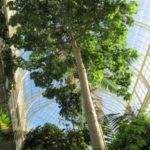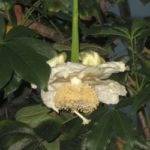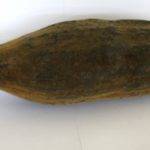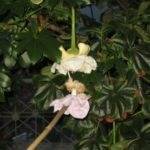The Baobab tree (Adansonia digitata) is one of Africa’s most enigmatic trees. In the wild it can look like an ‘upside down tree’ as the short spreading branches look like roots sticking in the air. One African legend has it that that god took a dislike to the Baobab and planted it upside down but it continued growing.
The huge trunk can grow to over 30 metres in diameter and trees reputedly can reach ages of many thousands of years. Our tree is a mere 13 years old but already it soars to the height of the Palmhouse (below).
The flowers open at night and trap a huge quantity of nectar (almost an egg-cup full) between their closely appressed petals and sepals. Along with its musty smell this attracts bats in the wild that push their tongues between the petals to retrieve the nectar.
The freshly opened flower has a curved style with a sticky stigma curved to one side (on the left you can see this is curving to the right).
In 1904 Roger Casement made a vital journey up the Congo river with explicit instructions to spy upon the activities of the private colony of King Leopold of Belgium. This colony (the Congo Free State) was conducting the most heinous crimes and exploitation upon the local population to enrich the King of Belgium’s fortunes. The loss of life and atrocities inspired literature such as Joseph Conrad’s Heart of Darkness.
The report that Roger Casement delivered to the British Government, along with his founding of the Congo Reform Association brought about an international outcry that led to the Annexation of the King’s private colony by the Belgian government. This remarkable experience moulded Casement’s future activities that ultimately led him to the Gallows in a London prison in 1916.
Roger Casement brought a number of botanical specimens back to Dublin after his Congo expedition, and one of these is a remarkably large Baobab fruit that is preserved in our Herbarium museum (below).
It seems fitting in this anniversary year of Casement’s death that we try to grow a Baobab fruit on our own tree, and work is under way to attempt cross-pollination of the flowers using the previous night’s blooms (below).




